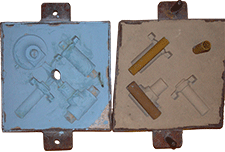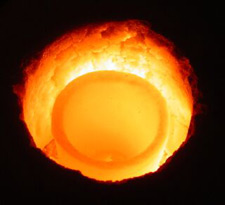Home | Glossary | Resources | Help | Contact Us | Course Map
Archival Notice
This is an archive page that is no longer being updated. It may contain outdated information and links may no longer function as originally intended.
Metal-Forming Operations
Metal forming can be divided into two categories: gross forming and fine forming . Gross forming reduces raw metal stock to a rough form that is intermediate to the required shape. Fine forming renders the intermediate form to its final dimensions, with the exception of parts requiring hand fitting. Fine forming is discussed in a later section of this module.
Casting
Sand molds have been a mainstay of foundries for centuries. Molten metal is poured into a mold; the hollow interior is the negative of the desired part. The mold must be able to withstand the heat of molten metal.
Traditionally, a master wooden pattern is created and packed in sand in two halves of a mold. The halves are known as the cope and the drag. The cope and the drag are separated and the wooden pattern removed. Molten metal is poured into the cavity through a sprue hole and allowed to harden. The cope and drag are separated and the part is removed for possible additional fine forming. Sand is recycled to be used for future molds. This process is known as casting.
Another casting method, known as the lost (sacrificial) wax process, does not require the removal of the wooden pattern. Instead, a sacrificial wax pattern melts and runs out of the mold; the mold retains the shape of the part as a cavity. Molten metal poured into the mold fills the cavity and cools to the same shape.
Wax or sand molds are broken away to release the newly founded metal part. Gun parts are not large and may be cast several at a time. Multiple parts can be cast in a single wax form and are connected by runners or gates as a means to distribute the molten metal evenly to the various parts. The tree-like metal casting is cut or broken at the runners to release the individual parts. Depending on the master pattern and how the mold is prepared, the resulting casting may have a rough surface finish.
Traditionally, ferrous alloys (containing iron) used for casting produced a rather brittle product. The slow cooling process creates loosely packed large crystals of iron (compared to other processes). As a result, cast iron gun parts are virtually obsolete, replaced by modern technology and materials.
A This file is licensed under Creative Commons Attribution ShareAlike 2.0 License.
Investment Casting
A modern version of lost wax casting has allowed the use of stronger steel alloys as well as any cast-capable metal alloy. Investment casting (IC) has been a significant influence in firearms manufacturing for nearly fifty years. Like the lost wax process, IC relies on sacrificial wax forms from a master mold. Unlike its predecessor, IC can produce precision parts of high-strength alloys. This level of precision allows a significant reduction in postprocess machining needed to produce a finished part. Investment casting starts with precision wax forms that are more detailed than those used in sand casting.
Steps in the IC method are described below:
- Using a precision wax form, parts are attached to runners by applying a small amount of extra hot wax to the part and attaching it to a runner.
- After the proper number of parts are combined on a runner, the assembly is repeatedly dipped in a slurry of fine ceramic material. This progressively builds up a shell around the wax.
- As the layer thickens, fine sand may be included in the buildup to strengthen the shell. The ceramic is much finer than the sand and can reproduce delicate features on the master, such as lettering. The goal is to produce a ceramic and sand mold whose interior surface is very fine, supported by a more durable layer of sand.
- After the shell reaches the proper thickness, the assembly is heated just enough to melt the wax, which flows out.
- The ceramic mold is then heated in a furnace to burn off any residual wax and fuse the shell. The mold is now ready to receive a charge of molten metal.
- The mold is preheated to slow the cooling time and permit better dimensional control. Metal poured into a cold mold may chill too quickly and not properly fill out the details in the mold.
- After preheating and pouring, the filled mold is allowed to cool.
- The cooled mold is struck, vibrated, or water-blasted to break away the brittle shell.
- Metal parts joined by runners are cut away. The cast parts are now ready for postcasting processing.
Today, some of the worlds strongest and most durable firearms have critical components that are products of investment casting.
See the YouTube Terms of Service and Google Privacy Policy
Die Casting
Die casting uses a permanent mold (versus the expendable sacrificial mold) to produce parts from low-strength, nonferrous alloys. The metals are typically low melting point alloys of zinc, such as ZAMAK, a zinc-aluminum blend. The process has been used for years in the making of metal toys and non-stressed hardware items. However, in the late 1960s, poor-quality handguns having major components of zinc-based alloys appeared on the commercial market in large numbers. Many made their way to the forensic firearms laboratories.
The advantages of die casting from zinc alloy are as follows:
- A single mold can produce usable parts over many years.
- The melting of zinc alloys requires less energy than for iron and aluminum alloys.
- The resulting parts are relatively easy to machine.
The disadvantages of die casting from zinc alloy are the following:
- It is difficult to produce precise tolerances.
- Voids or cracks can occur.
- The material strength is poor; wear occurs quickly.
- Untreated zinc alloys corrode easily and the raw surface is unattractive.
Most inexpensive handguns with zinc frames are plated with chrome to cover the physical flaws and rough surfaces. This is not to say that, with care, a reasonably good firearm cannot be made from die-cast components. However, the extra care involved would add significantly to the cost, which is of little interest to low-cost firearms manufacturers.
Additional Online Courses
- What Every First Responding Officer Should Know About DNA Evidence
- Collecting DNA Evidence at Property Crime Scenes
- DNA – A Prosecutor’s Practice Notebook
- Crime Scene and DNA Basics
- Laboratory Safety Programs
- DNA Amplification
- Population Genetics and Statistics
- Non-STR DNA Markers: SNPs, Y-STRs, LCN and mtDNA
- Firearms Examiner Training
- Forensic DNA Education for Law Enforcement Decisionmakers
- What Every Investigator and Evidence Technician Should Know About DNA Evidence
- Principles of Forensic DNA for Officers of the Court
- Law 101: Legal Guide for the Forensic Expert
- Laboratory Orientation and Testing of Body Fluids and Tissues
- DNA Extraction and Quantitation
- STR Data Analysis and Interpretation
- Communication Skills, Report Writing, and Courtroom Testimony
- Español for Law Enforcement
- Amplified DNA Product Separation for Forensic Analysts



